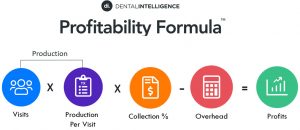What do you think is the best way to increase production and revenue? If your first answer was to acquire new patients: you aren’t alone. Most business owners think that scaling up their customer base is the top answer to the question of profitability.
“Every dentist wants to increase their production. So, their focus inevitably turns to look at new patients,” explains Rob Bay, president and co-founder of Dental Intelligence. “Adding new patients is one growth strategy. However, I see offices all the time that will have, say, 50, 100 or even 1,000 new patients and production isn’t increasing. They’re getting 50 and they’re losing 50.”
Rob calls this a classic “leaky bucket” problem. Imagine you have a bucket full of holes being filled with water. No matter how much you add to the bucket, you will steadily lose water until you plug the holes. It’s a great analogy for sustainable growth: if you don’t convert new patients to long-term active patients, you simply cannot fill your bucket. And, you will never experience growth if you can’t retain your current active patients.
According to Rob, two-thirds of new patients never return to a dental practice after their first appointment. Also, there are expensive and tangible monetary costs associated with acquiring those new patients. Consider our recent Orthodontic Practice Comparison Report, which indicated that in 2018, the average cost per new patient was $108. In addition, there is increased time and effort spent with new patients and insurance issues, creating significant opportunity costs. If most of those never return anyway, are there other ways your staff could spend that time to increase profits for your practice?
How Did Your Bucket Become Leaky?
Patient acquisition cost, conversion rates and attrition are other indicators that should be measured and tracked to paint a larger portrait of the leaky bucket problem. Without examining these indicators, it is hard to understand why new patients do not return or even why your existing patients become inactive.
However, the number of new patients and the cost of acquiring them are not necessarily the only key performance indicators you should track. Dental Intel has developed a formula with four primary drivers that equate to profitability:
- Number of patients seen in a given quantity of time (a month, year, etc.),
- Multiplied by how much being produced per visit,
- Multiplied by the collection percentage,
- Minus practice overhead.

“In many circumstances, people need to work on multiple areas. Most of the time, they need to increase their top line number, which will bring expenses in line,” explained Rob. “The way you do that is to look at the number of patients coming in and how much is produced per visit. Inevitably, this turns to looking at getting more new patients in. New patients are one component of growth but it’s not the end all be all.”
Measure, Monitor And Thrive
Retaining and scheduling is a large part of the journey to increased revenue because these actions convert patients to become long-lasting, active patients of the practice. There are a number of indications of attrition to consider:
- New patients aren’t scheduled for continuing care.
- After a broken appointment, no-show or cancellation, there is no follow-up to reschedule.
- Patients receive a hygiene exam and aren’t booked for their next one.
- Treatment is recommended but a patient wants time to think it over or speak to their spouse before making an appointment.
“Most dentists think they are doing better with attrition than they actually are doing because they have systems and policies. But, they aren’t actually looking at it or measuring it. So, they have a false belief in what that number is. They often think it’s over 90%, but the average is about 56%,” Rob noted. “It’s likely that if they aren’t measuring and monitoring that number neither is their staff—and they are only getting about half of their patients to schedule their hygiene appointments.”
Even with the proper systems in place, it’s important to measure these numbers and review them regularly, which allows your practice to make small adjustments to those processes. Rob also notes that many times, simply implementing accountability with reporting increases the number of active patients and ensures new patients are always being scheduled for upcoming exams or treatment.
“If you are a dentist and your average is at 56% or less, that’s a good situation to be in because it means you can make an improvement,” Rob encouraged. “You can make changes and it will make a huge improvement for your practice.”
Start Improving Today
In our new edition of the Orthodontic Practice Comparison Report, CWA orthodontic practices share statistics on the number of new patient exams, as well as conversion rates and new patient acquisition cost. Looking to make strategic improvements so that you can achieve financial freedom? Reach out to our team for a complimentary consultation today.














